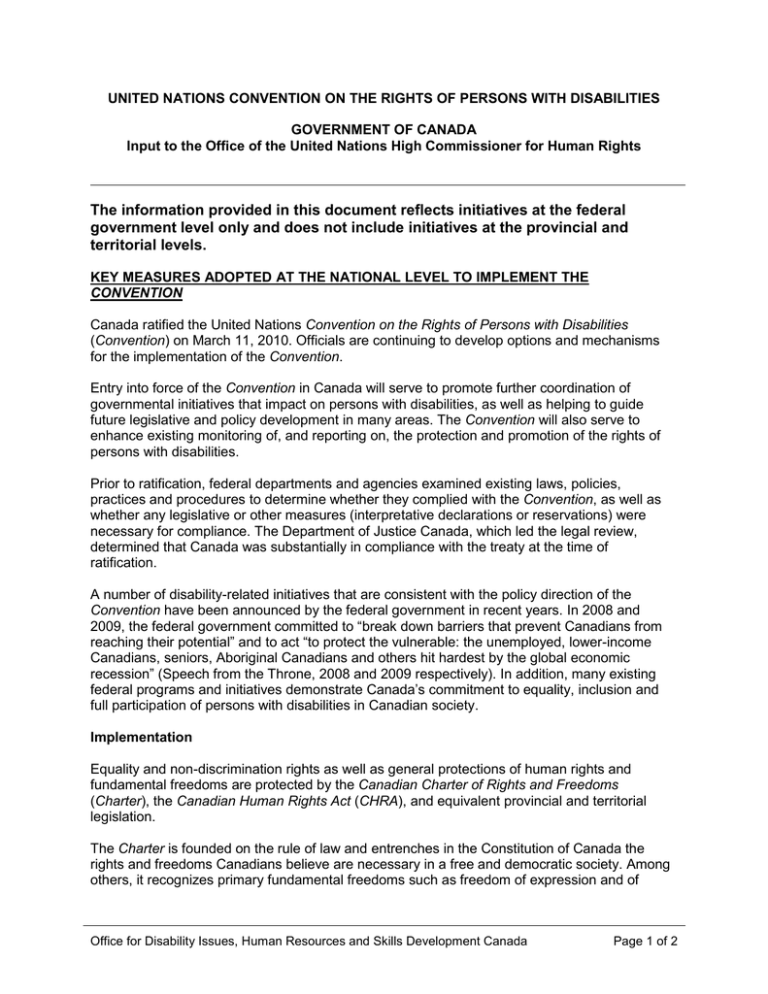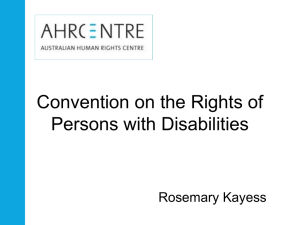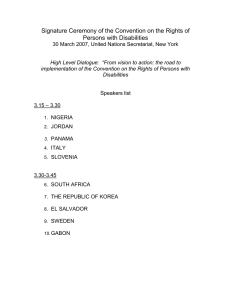Document 17711216
advertisement

UNITED NATIONS CONVENTION ON THE RIGHTS OF PERSONS WITH DISABILITIES GOVERNMENT OF CANADA Input to the Office of the United Nations High Commissioner for Human Rights The information provided in this document reflects initiatives at the federal government level only and does not include initiatives at the provincial and territorial levels. KEY MEASURES ADOPTED AT THE NATIONAL LEVEL TO IMPLEMENT THE CONVENTION Canada ratified the United Nations Convention on the Rights of Persons with Disabilities (Convention) on March 11, 2010. Officials are continuing to develop options and mechanisms for the implementation of the Convention. Entry into force of the Convention in Canada will serve to promote further coordination of governmental initiatives that impact on persons with disabilities, as well as helping to guide future legislative and policy development in many areas. The Convention will also serve to enhance existing monitoring of, and reporting on, the protection and promotion of the rights of persons with disabilities. Prior to ratification, federal departments and agencies examined existing laws, policies, practices and procedures to determine whether they complied with the Convention, as well as whether any legislative or other measures (interpretative declarations or reservations) were necessary for compliance. The Department of Justice Canada, which led the legal review, determined that Canada was substantially in compliance with the treaty at the time of ratification. A number of disability-related initiatives that are consistent with the policy direction of the Convention have been announced by the federal government in recent years. In 2008 and 2009, the federal government committed to “break down barriers that prevent Canadians from reaching their potential” and to act “to protect the vulnerable: the unemployed, lower-income Canadians, seniors, Aboriginal Canadians and others hit hardest by the global economic recession” (Speech from the Throne, 2008 and 2009 respectively). In addition, many existing federal programs and initiatives demonstrate Canada’s commitment to equality, inclusion and full participation of persons with disabilities in Canadian society. Implementation Equality and non-discrimination rights as well as general protections of human rights and fundamental freedoms are protected by the Canadian Charter of Rights and Freedoms (Charter), the Canadian Human Rights Act (CHRA), and equivalent provincial and territorial legislation. The Charter is founded on the rule of law and entrenches in the Constitution of Canada the rights and freedoms Canadians believe are necessary in a free and democratic society. Among others, it recognizes primary fundamental freedoms such as freedom of expression and of Office for Disability Issues, Human Resources and Skills Development Canada Page 1 of 2 association; democratic rights; and the multicultural heritage of Canadians. Section 15 of the Charter came into effect on April 17, 1985, and was an important milestone for the rights of people with disabilities where it was at last recognized that every individual, regardless of physical or intellectual disability, is equal before and under the law, and has the right to the equal protection and equal benefit of the law without discrimination. The purpose of the CHRA is is to extend the laws in Canada to give effect, within the purview of matters coming within the legislative authority of Parliament, to the principle that all individuals should have an opportunity equal with other individuals to make for themselves the lives that they are able and wish to have and to have their needs accommodated, consistent with their duties and obligations as members of society, without being hindered in or prevented from doing so by discriminatory practices based on race, national or ethnic origin, colour, religion, age, sex, sexual orientation, marital status, family status, disability or conviction for an offence for which a pardon has been granted. Canada’s federal government has existing legislation, policies, programs and practices which promote the principles of equality, dignity and an enabling environment for persons with disabilities. These include, but are not limited to: awareness-raising measures, accessibility guidelines and standards, income support and tax measures, the Canada Social Transfer, support for victims of crime, and the Employment Equity Act (EEA). The EEA requires employers covered by the Act to report annually on their performance to ensure inclusion, fairness and equal access to employment opportunities for the four designated groups: women, persons with disabilities, Aboriginal peoples and members of visible minorities. Results over the past years indicate progress in the employment situation of the four designated groups. The Convention will also continue to be implemented progressively through federal, provincial and territorial laws, policies and practices as they are developed over time. Please refer to Annex A for a list of programs, policies and legislation currently in place in Canada supporting implementation of the Convention. Office for Disability Issues, Human Resources and Skills Development Canada Page 2 of 2


